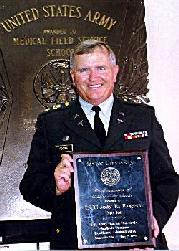

BS, Univ. Wisconsin, Stevens Point, WI, 1976
MSBA, Boston Univ., Boston, MA, 1982
MHA, Baylor Univ., Waco, TX, 1985
Ph.D., Univ. Minnesota, MN, 1993
Regent Army, Western Region, ACHE, 1996-99
Faculty, Trinity Univ., San Antonio, TX, 2002 to present
Prin. Hlth. Sys. Anal., PEC Solutions, San Antonio, TX, 2000-02
Program Director, U.S. Army-Baylor Univ., Academy of Health Sci., Ft. Sam Houston, TX, 1996-98
Dep. Program Director, U.S. Army-Baylor Univ., Academy of Health Sci., Ft. Sam Houston, TX, 1995-96
Chief, Off. Strategic Plan., Health Services Command, Ft. Sam Houston, TX, 1993-95
Asst. IG, Health Services Command, Ft. Sam Houston, TX, 1989-90
Adm., Med. Dept., Brooke AMC, Ft. Sam Houston, TX, 1986-89
Staff off., OTSG, Washington, DC, 1985-86
Resident, Kimbrough ACH, Ft. Meade, MD, 1984-85
Class size continued to fluctuate between 35 and 50 students. The Program experienced difficulty recruiting Medical Service Corps Officers and subtle changes to the selection process were instituted to increase MSC involvement. In the past, MSCs attending Baylor were required to change their AOC to 70A (Healthcare Administrator). The slow promotion rates of healthcare administrators to Colonel appeared to be scaring qualified officers from attending Baylor because they did not want to be forced to become 70As. With the support of the 70A Consultant, Colonel George Masi, MSCs attending Baylor were given the option of keeping their old AOC. In other words, the focus of recruitment was to encourage the best and brightest MSCs to attend Baylor regardless of their AOC. These officers may have to serve at least one utilization tour in a 70A position, but they did not have to change their AOC. As a result of this subtle change to the recruitment process, many more officers from other AOCs began attending Baylor. This increase in diversification was intended to enhance the quality of MSC officers by allowing non-70A the opportunity to obtain a graduate education from a nationally recognized institution and thus, better prepare them for jobs in TOE and TDA organizations.
The pressure to add more courses and more material in a given course continued unabated during this time. The demand for officers with strong quantitative skills continued to increase. Course content in terms of teaching new and more complex quantitative skills continued to grow. As a result, the stress level of students also continued to grow.
The Program continued to be an integral part of the Center for Healthcare Education and Studies. Colonel Stuart Baker was the Chief, CHES until 1999 when Colonel Harrison Hassell replaced him.
While serving as the Director, I was also the Regent for the Army's Western Region, ACHE, and the President of the Baylor Alumni Association. Having all three jobs at the same time gave me an interesting perspective of military and civilian healthcare administration and also of the tremendous pride that Baylor Alumni have for our Program.
The Deputy Program Director during my tenure was CDR Elaine Ehresmann, USN and then LTC Charles Wainright. LTC Wainright became the Deputy in 1998. Both Officers were extremely confident and capable of providing the support necessary to lead this Program.
The second significant involvement I had with Baylor was as a student and graduate from 1983-1985. I was the second Laboratory Officer to attend Baylor. My experience as a student was outstanding because of the outstanding officers who were students of mine and because of the excellent education I received. We had 35 officers in class with two Navy and two Air Force officers in attendance. Our co-class leaders were a Veterinarian, Major Tom Catanzaro, and a Psychologist, Major Larry Reed. The class of 1985 was the first four-semester class. Previous to this time, Baylor classes were 9 months in length and only 3 semesters long. Although it was designed for 12 months of study, our class time was only 10 months in order to get on the schedule that the program currently has. We started in late September and finished in early August. Today, class begins 1 July and ends one year later. Needless to say, putting 4 semesters of study into 10 months was extremely taxing for the students and the faculty. In fact, for most of our 4th semester, two classes were going at the same time as the class of 1986 started in late June and we didn't finish out studies until late August. This affected our classes' morale in a significant way. By the time of orals, we were burned out from not having a regular classroom, not having dedicated faculty, and the whole orals process. The stress level was so great that our class leader and one faculty member almost came to blows during a class.
One of my classmates, LTC Eric Rubel, became a physician in subsequent years. Dr. Tom Catanzaro, VC, became the only Veterinarian in the ACHE to become a Fellow in the College. Several classmates became Colonels and at least two of us earned our Doctorates. One died tragically while on active duty. I currently am a Visiting Professor at Trinity University in San Antonio, Texas.
The COP also has a place for the Army-Baylor Program to list the courses offered and the syllabi for each of these courses. Baylor students are also members of the community and they can access class material using this site and they can communicate directly with DCAs should they have a question concerning some aspect of healthcare.